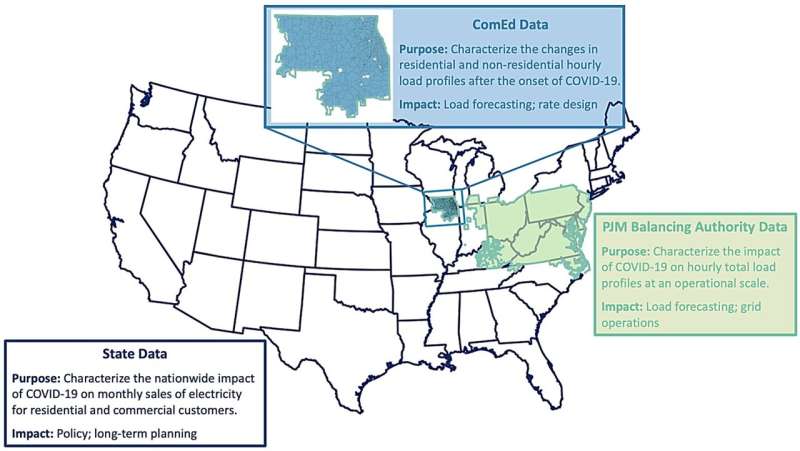Researchers find that detail matters for understanding COVID-19 impacts on electricity use

In the spring of 2020, most offices and schools shuttered, causing people to move work and school to their homes. This created an unprecedented source of uncertainty for the electrical grid. How would COVID-19 affect electricity demand? How could utilities forecast these kinds of changes to make sure the lights stayed on? Researchers at Pacific Northwest National Laboratory (PNNL) analyzed a series of unique datasets to find out in a new research article.
Data from the Commonwealth Edison (ComEd) utility showed that changes in the daily pattern of electricity demand occurred immediately after lockdowns began. Overall, total (residential plus non-residential) weekday hourly demand decreased and the timing of demand changed.
Prior to lockdowns, demand would typically increase in the early morning as people got ready for work, decline during the day, and then increase in the evenings after people returned home. After the onset of COVID-19, the PNNL team noted a proportionately larger and later increase in the morning and a later increase in the evening. These kinds of changes are important for planning electricity grid operations, as utilities carefully manage supply resources to meet changes in demand.
Understanding demand drivers
What was driving the changes in total demand? Certainly part of the story was that many people shifted to working from home, but what was happening with electricity use in commercial buildings? The ComEd data separated residential and non-residential demand. This allowed the PNNL team to dig deeper.
Most research on electricity demand is either focused on very fine scales, such as individual buildings, or on large scales, such as the balancing authority level. This is a regional scale where designated companies work to balance electricity supply and total demand. "We found a gap in research where people hadn't gotten data at the right scales to understand the underlying drivers," said Nathalie Voisin, a PNNL Earth scientist and co-author of the study.
For residential demand, the team found that weekday electricity use in homes had morphed to look like typical weekend use. This meant a gentler increase in electricity use during the morning with sustained consumption throughout the day. Some utilities characterized it as "a perpetual snow day." The team showed that non-residential demand declined in every hour of the day, but the hour-to-hour variability did not change since most commercial buildings have fixed schedules. It was the combination of these changes that produced the total demand changes.
Examining data across a range of scales allowed the team to highlight the importance of customer-class data. The team continued to analyze electricity usage at different scales when pandemic lockdowns eased during the summer of 2020.
Smaller scales show big effects
The PNNL team found that temperatures during the summer turned out to be a larger factor for residential electricity demand than whether people were teleworking. During the summer, the amount of cooling in residential buildings depends strongly on the weather regardless of daytime occupancy. Although more people were working from home, there was not substantially more demand for air conditioning since their homes would have been cooled anyway.
In addition, the regional differences in reopening schedules produced a range of demand signals. At regional scales, the mixture of demand between reopened and closed regions prevented dramatic shifts in demand due to COVID-19.
"We were the first to identify specific effects that muted the COVID signal," said Casey Burleyson, a PNNL Earth scientist and lead author of the paper. "This paper shows that examining effects across a range of scales is critically important."
This approach builds a more holistic picture of electricity demand. Understanding the core drivers of demand is important to developing accurate models and preparing a more resilient grid.
The right data can be hard to find
The scientists say that the smaller-scale data central to this work is hard to obtain. Referred to as customer class data, it breaks down demand into customer types and ideally, building types. These include residential, commercial, and industrial classes and building type distinctions, such as single-family homes and apartment buildings. However, privacy laws keep much of this data proprietary.
"I think our work shows how crucial customer class data is for understanding how the grid reacts to unexpected events," said Jennie Rice, a PNNL systems engineer and the project lead.
Fortunately, ComEd makes anonymized data by customer class available to researchers for a small fee. Increased access to similar data from around the country would help researchers create models that accurately forecast future changes in electricity demand due to unexpected events like COVID-19.
In addition to Burleyson, Rice, and Voisin, the research team included Aowabin Rahman and Amanda D. Smith.
More information: Casey D. Burleyson et al, Multiscale effects masked the impact of the COVID-19 pandemic on electricity demand in the United States, Applied Energy (2021). DOI: 10.1016/j.apenergy.2021.117711

















